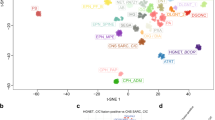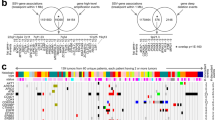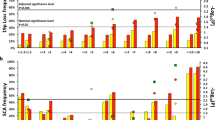Abstract
Alterations of 19q13 are frequently observed in glial neoplasms, suggesting that this region harbors at least one gene involved in gliomagenesis. Following our previous studies on structural 19q chromosome rearrangements in gliomas, we have undertaken a detailed FISH analysis of the breakpoints and identified a 19q13.2 intrachromosomal amplification of the MAP/microtubule affinity-regulating kinase 4 (MARK4) gene in three primary glioblastoma cell lines. Recent data suggest that this gene is involved in the Wnt-signaling pathway. We observed that the expression of the alternatively spliced MARK4L isoform is upregulated in both fresh and cultured gliomas and overexpressed in all of the above three glioblastoma cell lines. Interestingly, we also found that MARK4L expression is restricted to undifferentiated neural progenitor cells or proliferating glial precursor cells, whereas its expression is downregulated during glial differentiation. Perturbation of expression using antisense oligonucleotides against MARK4 in glioblastoma cell lines, consistently induced a decreased proliferation of tumor cells. Taken together, these data show that MARK4, which is normally expressed in neural progenitors, is re-expressed in gliomas and may become a key target of intrachromosomal amplification upon 19q rearrangements.
This is a preview of subscription content, access via your institution
Access options
Subscribe to this journal
Receive 50 print issues and online access
$259.00 per year
only $5.18 per issue
Buy this article
- Purchase on Springer Link
- Instant access to full article PDF
Prices may be subject to local taxes which are calculated during checkout







Similar content being viewed by others
References
Bello MJ, Leone PE, Vaquero J, de Campos JM, Kusak ME, Sarasa JL, Pestana A and Rey JA . (1995). Int. J. Cancer, 64, 207–210.
Bigner SH, Mark J, Burger PC, Mahaley MSJ, Bullard DE, Muhlbaier LH and Bigner DD . (1988). Cancer Res., 88, 405–411.
Chernova O and Cowell JK . (1998). Cancer Genet. Cytogenet., 105, 60–68.
Chernova OB, Somerville RPT and Cowell JK . (1998). Oncogene, 17, 2873–2881.
Coquelle A, Pipiras E, Toledo F, Buttin G and Debatisse M . (1997). Cell, 89, 215–225.
Ekstrand AJ, James CD, Bigner SH, Grzeschik CH, Humphrey PA, Bigner DS, Vogelstein B . (1991). Cancer Res., 51, 2164–2172.
El-Azouzi M, Chung RY, Farmer GE, Martuza RL, Black PM, Rouleau GA, Hettlich C, Hedley-Whyte ET, Zervas NT and Panagopoulos K . (1989). Proc. Natl. Acad. Sci. USA, 86, 7186–7190.
Fan S, Wang J-A, Yuan R-q, Ma YX, Meng Q, Erdos MR, Brody LC, Goldberg ID and Rosen EM . (1998). Oncogene, 16, 3069–3083.
Guha A, Dashner K, Black PM, Wagner JA and Stiles CD . (1995). Int. J. Cancer, 60, 168–173.
Hartmann C, Johnk L, Kitange G, Wu Y, Ashworth LK, Jenkins RB and Louis D . (2002). Cancer Res., 62, 4100–4108.
Hellman A, Zlotorynski E, Scherer SW, Cheung J, Vincent JB, Smith DI, Trakhtenbrot L and Kerem B . (2002). Cancer Cell, 1, 89–97.
Henson JW, Schnitker BL, Correa KM, von Deimling A, Fassbender F, Xu HJ, Benedict WF, Yandell DW and Louis DN . (1994). Ann. Neurol., 36, 714–721.
Holland EC . (2001). Nat. Genet. Rev., 2, 120–129.
Jen J, Harper JW, Bigner SH, Bigner DD, Papadopoulos N, Markowitz S, Willson JK, Kinzler KW and Vogelstein B . (1994). Cancer Res., 54, 6353–6358.
Kato T, Satoh S, Okabe H, Kitahara O, Ono K, Kihara C, Tanaka T, Tsunoda T, Yamaoka Y, Nakamura Y and Furukawa Y . (2001). Neoplasia, 3, 4–9.
Koch A, Waha A, Tonn JC, Sorensen N, Berthold F, Wolter M, Reifenberger J, Hartmann W, Friedl W, Reifenberger G, Wiestler OD and Pietsch T . (2001). Int. J. Cancer, 93, 445–449.
Lee JC, Mayer-Proscherl M and Rao MS . (2000). Glia, 30, 105–121.
Louis DN, Pomeroy SL and Cairncross JG . (2002). Cancer Cell, 1, 125–128.
Magnani I, Chiariello E, Fuhramn Conti AM and Finocchiaro G . (1999). Cancer Genet. Cytogenet., 110, 82–86.
Magnani I, Guerneri S, Pollo B, Cirenei N, Colombo BM, Broggi G, Galli C, Bugiani O, Di Donato S, Finocchiaro G and Conti AMF . (1994). Cancer Genet. Cytogenet., 75, 77–89.
Marsden HB, Kumar S, Kahn J and Anderson BJ . (1983). Int. J. Cancer, 31, 439–444.
Megason SG and McMahon AP . (2002). Development, 129, 2087–2098.
Mollenhauer J, Wiemann S, Scheurlen W, Korn B, Hayashi Y, Wilgenbus KK, Deimling A and Poustka A . (1997). Nat. Genet., 17, 32–33.
Nagase T, Nakayama M, Nakajima D, Kikuno R and Ohara O . (2001). DNA Res., 8, 85–95.
Nobel M and Mayer-Proschel M . (1997). J. Neuro-oncol., 35, 193–209.
Perego P, Boiardi A, Carenini N, De Cesare M, Dolfini E, Giardini R, Magnani I, Martignone S, Silvani A, Soranzo C and Zunino F . (1994). J. Cancer Res. Clin. Oncol., 120, 585–592.
Reifenberger G, Reifenberger J, Ichimura K and Collins VP . (1995). Cancer Res., 55, 731–734.
Reifenberger G, Reifenberger J, Ichimura K, Meltzer PS and Collins VP . (1994). Cancer Res., 54, 4299–4303.
Ritland SR, Ganju V and Jenkins RB . (1995). Genes Chromosomes Cancer, 12, 277–282.
Rosenberg JE, Lisle DK, Burwick JA, Ueki K, Deimling A, Mohrenweiser HW and Louis DN . (1996). Oncogene, 13, 2483–2485.
Roth W, Wild-Bode C, Platten M, Grimmel C, Melkonyan HS, Dichgans J and Weller M . (2000). Oncogene, 19, 4210–4220.
Sano T, Lin H, Chen X, Langford LA, Koul D, Bondy ML, Hess KR, Myers JN, Hong YK, Yung WK and Steck PA . (1999). Cancer Res., 59, 1820–1824.
Satoh J and Kuroda Y . (2000). Neuropathology, 20, 113–123.
Schrock E, Thiel G, Lozanova T, Manoir S, Meffert MC, Jauch A, Speicher MR, Numberg P, Vogel S and Janisch W . (1994). Am. J. Pathol., 144, 1203–1218.
Smith JS, Tachibana I, Lee HK, Qian J, Pohl U, Mohrenweiser HW, Borell TJ, Hosek SM, Soderberg CL, Deimling A, Perry A, Scheithauer BW, Louis DN and, Jenkins RB . (2000). Genes Chromosomes Cancer, 29, 16–25.
Sutherland GR and Richards RI . (1995). Curr. Opin. Genet. Dev., 5, 323–327.
Svendsen CN, Borg MG, Armstrong RJE, Rosser AE, Chandran S, Ostenfeld T and Caldwell MA . (1998). J. Neurosci. Methods, 85, 141–152.
Takahashi J, Fukumoto M, Igarashi K, Oda Y, Kikuchi H and Hatanaka M . (1992). J. Neurosurg., 76, 792–798.
von Deimling A, Louis DN, Ammon K, Petersen I, Wiestler OD and Seizinger BR . (1992). Cancer Res., 52, 4277–4279.
Vrieling H . (2001). Nat. Genet., 28, 101–102.
Wong AJ, Ruppert JM, Bigner SH, Grzeschik CH, Humphrey PA, Bigner DS and Vogelstein B . (1992). Proc. Natl. Acad. Sci. USA, 89, 2965–2969.
Zurawel RH, Chiappa SA, Allen C and Raffael C . (1998). Cancer Res., 58, 896–899.
Acknowledgements
We thank Lawrence Livermore National Laboratory for providing cosmids LLNL-R32611, LLNL-F18718, LLNL-R31237, LLNL-R33632, LLNL-F19186, LLNL-F15123, LLNL-F10080, LLNL-F13544, LLNL-F20720 and LLNL-R32889. This research was supported by AIRC (Associazione Italiana Ricerca sul Cancro) 2001 (LL and GF) and in part from Grant CA76457 from the National Institutes of Health (JKC)
GenBank accession numbers
We obtained the genomic sequence spanning the human MARK4 gene from two cosmids: R31237 (AC005581) and R33632 (AC005781). Human MARK4 partial coding sequences isolated from anaplastic oligodendroglioma have been deposited into GenBank (AI869600, AI939391). MARK4S cDNA (KIAA1860, AB049127), MARK4L (AY120867). The cDNA referred in NCBI's GenBank as MARK4 corresponds to the MARK4L isoform (AY057448).
Author information
Authors and Affiliations
Corresponding author
Rights and permissions
About this article
Cite this article
Beghini, A., Magnani, I., Roversi, G. et al. The neural progenitor-restricted isoform of the MARK4 gene in 19q13.2 is upregulated in human gliomas and overexpressed in a subset of glioblastoma cell lines. Oncogene 22, 2581–2591 (2003). https://doi.org/10.1038/sj.onc.1206336
Received:
Revised:
Accepted:
Published:
Issue Date:
DOI: https://doi.org/10.1038/sj.onc.1206336
Keywords
This article is cited by
-
The metabolic stress-activated checkpoint LKB1-MARK3 axis acts as a tumor suppressor in high-grade serous ovarian carcinoma
Communications Biology (2022)
-
MARK2 regulates chemotherapeutic responses through class IIa HDAC-YAP axis in pancreatic cancer
Oncogene (2022)
-
Rosmarinic Acid Exhibits Anticancer Effects via MARK4 Inhibition
Scientific Reports (2020)
-
Probing the Inhibition of Microtubule Affinity Regulating Kinase 4 by N-Substituted Acridones
Scientific Reports (2019)
-
MARK4 protein can explore the active-like conformations in its non-phosphorylated state
Scientific Reports (2019)



